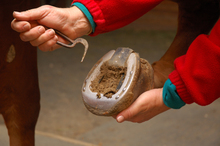Why Picking a Horse's Hooves Is Important
Horse's hooves are prone to picking up bits of gravel, dirt, and debris on a regular basis, especially if they are out on the trail, in a paddock, or pasture. If the hooves are not picked, these pieces of gravel or debris can lead to discomfort, infection, and lameness.

Using special tool to pick hoof
Picking involves use of a specialized tool to remove any dirt, rocks, nails, or debris that become trapped in the areas around the frog.
In addition, picking the hooves helps a horse owner to identify puncture wounds or other problems with a hoof at the earliest stage.
A horse that is being ridden on a regular basis should have its hooves picked and cleaned before and after each ride. Other horses should have their hooves picked daily, if possible, or at least a couple of times each week so any hoof problems are caught in the earliest stages.
Picking involves use of a specialized tool to remove any dirt, rocks, nails, or debris that become trapped in the areas around the frog. A final swipe with a brush removes any remaining dust or dirt from the hoof.
Follow these 3 basic steps to do a thorough cleaning of your horse's hooves:
- Pick up the horse's foot so that the bottom can be seen clearly. Stand near the horse's left front leg, facing its rear, and run your left hand down the horse's leg, toward the pastern. Some horses will pick up the foot automatically, but others need a little more physical involvement. In this case, lean your left shoulder against the horse's shoulder, encouraging it to shift the weight to the opposite leg. Gently squeeze the back of the leg. Given a little pressure, most horses will then pick up the foot, enabling you to cradle the foot in your hand. Keep the angle of the leg natural and don't bend it off to the side.
- To clean out the inside of the hoof, take the pick in your right hand and, pointing the pick away from you, scrape out any dirt or manure with the tip of the pick, paying special attention to the sole and frog. Clean the areas around the frog, but don't scrape it. Look carefully for any debris, small rocks, or objects that need to be dislodged. As you pick the hoof, inspect it carefully for any punctures, injuries, or signs of infection. Now, it's time to brush the hoof to remove all traces of dirt or manure.
- Once the left front hoof is picked and cleaned, move to the hind leg on the left side and repeat the picking, cleaning, observing, and brushing. Typically, tradition has the picking and cleaning rotation start from the front left hoof, continue to the hind left hoof, then to the right hind hoof, finishing with the right front hoof. When working on the horse's right side, it is usually easiest to hold the hoof in your right hand and do the picking and cleaning with your left hand.
In some cases, the horse may be reluctant to cooperate and won't lift its feet. The horse should be examined to make sure it is healthy and not experiencing pain in one or more legs.
If no physical problems are found, it will be necessary to train the horse to have its feet lifted and worked on. A farrier or trainer will be able to help you work with the horse so lifting the hooves becomes a natural part of the grooming and cleaning process.
